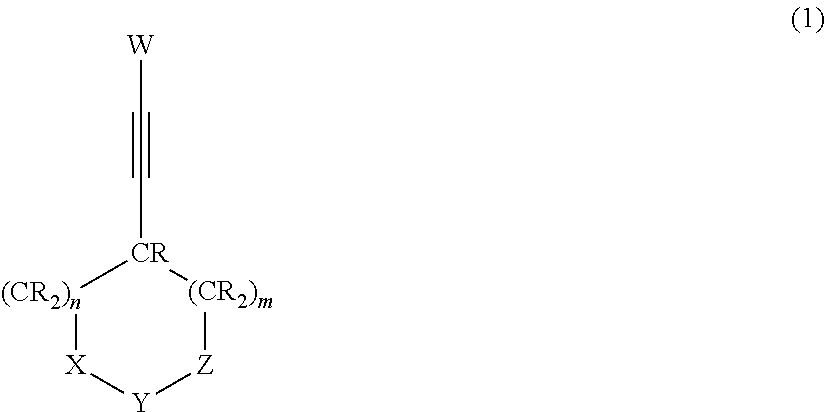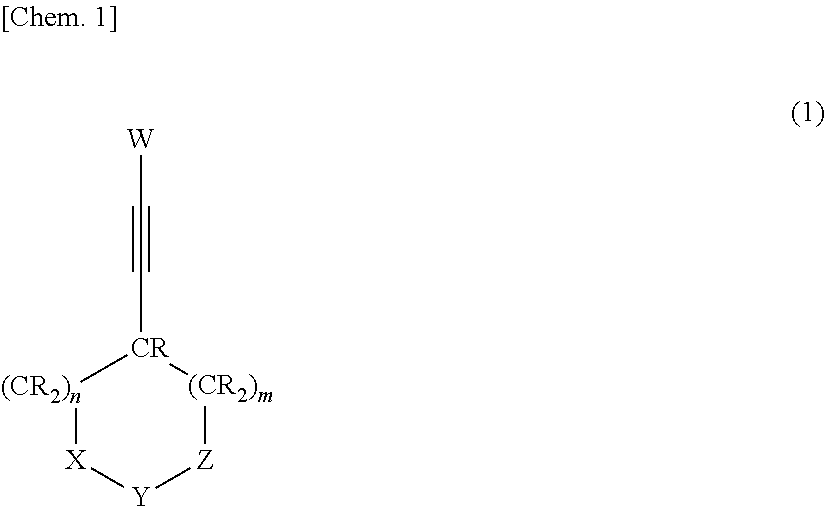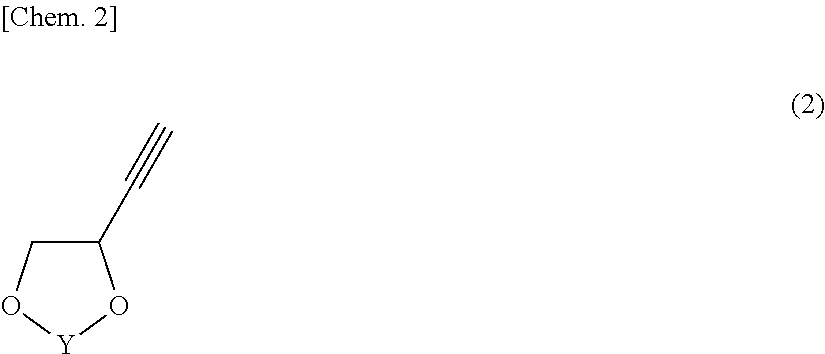Nonaqueous electrolytic solution and nonaqueous electrolyte secondary battery
a nonaqueous electrolyte and secondary battery technology, applied in the direction of primary cells, non-aqueous electrolyte cells, electrochemical generators, etc., can solve the problems of clogging of electrode layers and separators, unusable batteries, and oxidative decomposition of unsaturated cyclic carbonates on positive electrodes, etc., to improve durability, improve stability, and enhance battery durability
- Summary
- Abstract
- Description
- Claims
- Application Information
AI Technical Summary
Benefits of technology
Problems solved by technology
Method used
Image
Examples
examples
[0307]The present invention will be explained in more detail next based on examples and comparative examples. However, the present invention is not limited to these examples.
[0308]The compound of formula (1) used in the present examples was synthesized according to the method described below.
[0309]Starting material 1) was synthesized in accordance with the method of Non-Patent Document (JOC., 56(3), 1083-1088 (1991)). Next, compound A was obtained in accordance with the method set forth in Eur. J.O.C, 2009(20), 2836-2844, using the starting material 1).
[0310]The spectral data of compound A is as follows.
TABLE 1Mass Spectrum1H NMR in CDCl3CompoundCI, m / zEI, m / zppm vs TMS 112 [M+] 52 [C4H4]2.80(1H) 4.39-4.44(1H) 4.64-4.68(1H) 5.30-5.34(1H)
example a
Production of a Negative Electrode
[0311]A slurry was formed by adding 100 parts by weight of an aqueous dispersion of sodium carboxymethyl cellulose (sodium carboxymethyl cellulose concentration 1 wt %), and 1 part by weight of an aqueous dispersion of styrene-butadiene rubber (styrene-butadiene rubber concentration 50 wt %), as a thickener and a binder, respectively, to 98 parts by weight of a carbonaceous material, with mixing in a disperser. The obtained slurry was coated onto a 10 μm-thick copper foil, was dried, and was rolled using a press. The rolled product was cut to a shape having a width of 30 mm and a length of 40 mm, as the size of the active material layer, and having an uncoated portion having a width of 5 mm and a length of 9 mm, to yield a negative electrode that was used in Examples 1 to 7, Comparative Examples 1 to 5 and Reference Example 1.
Production of a Positive Electrode
[0312]A slurry was formed by mixing, in an N-methyl pyrrolidone solvent, 90 wt % of LiCoO2,...
example b
Production of a Positive Electrode
[0319]A slurry was formed by mixing, in an N-methyl pyrrolidone solvent, 90 wt % of Li(Ni1 / 3Mn1 / 3Co1 / 3)O2, as a positive electrode active material, 5 wt % of acetylene black, as a conductive material, and 5 wt % of polyvinylidene fluoride, as a binder. The obtained slurry was applied onto a 15 μm-thick aluminum foil that had been coated beforehand with a conductive aid, was dried, and was rolled using a press. The rolled product was cut to a shape having a width of 30 mm and a length of 40 mm, as the size of the active material layer, and having an uncoated portion having a width of 5 mm and a length of 9 mm, to yield a positive electrode that was used in Examples 8 to 10, Comparative Examples 6 to 11 and Reference Example 2.
Production of an Electrolyte Solution
[0320]A base electrolyte solution was prepared by dissolving dried LiPF6 in a mixture of ethylene carbonate, dimethyl carbonate and ethylmethyl carbonate (volume ratio 30:30:40), to a proport...
PUM
| Property | Measurement | Unit |
|---|---|---|
| voltage | aaaaa | aaaaa |
| temperature | aaaaa | aaaaa |
| swelling | aaaaa | aaaaa |
Abstract
Description
Claims
Application Information
 Login to View More
Login to View More - R&D
- Intellectual Property
- Life Sciences
- Materials
- Tech Scout
- Unparalleled Data Quality
- Higher Quality Content
- 60% Fewer Hallucinations
Browse by: Latest US Patents, China's latest patents, Technical Efficacy Thesaurus, Application Domain, Technology Topic, Popular Technical Reports.
© 2025 PatSnap. All rights reserved.Legal|Privacy policy|Modern Slavery Act Transparency Statement|Sitemap|About US| Contact US: help@patsnap.com



